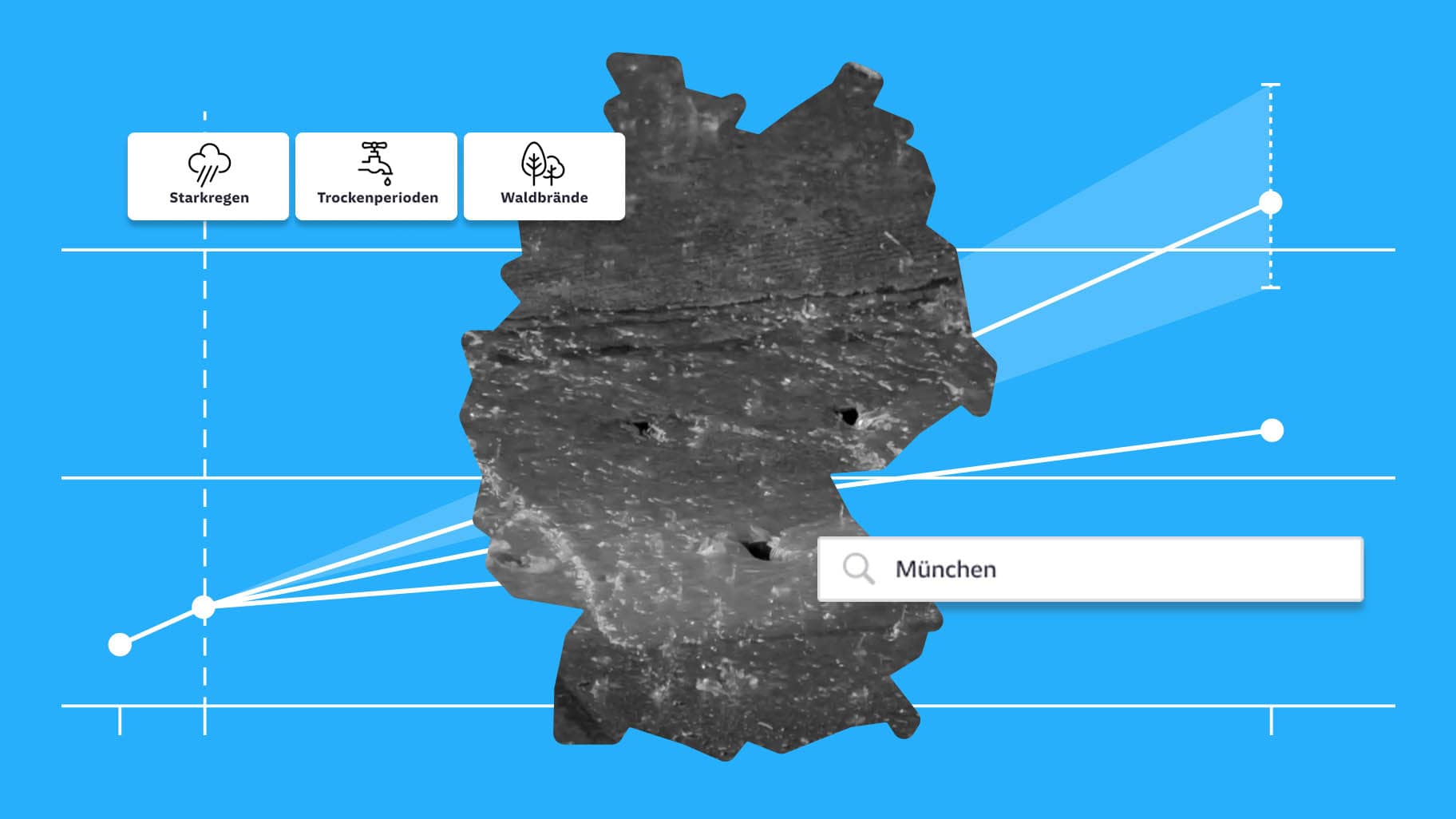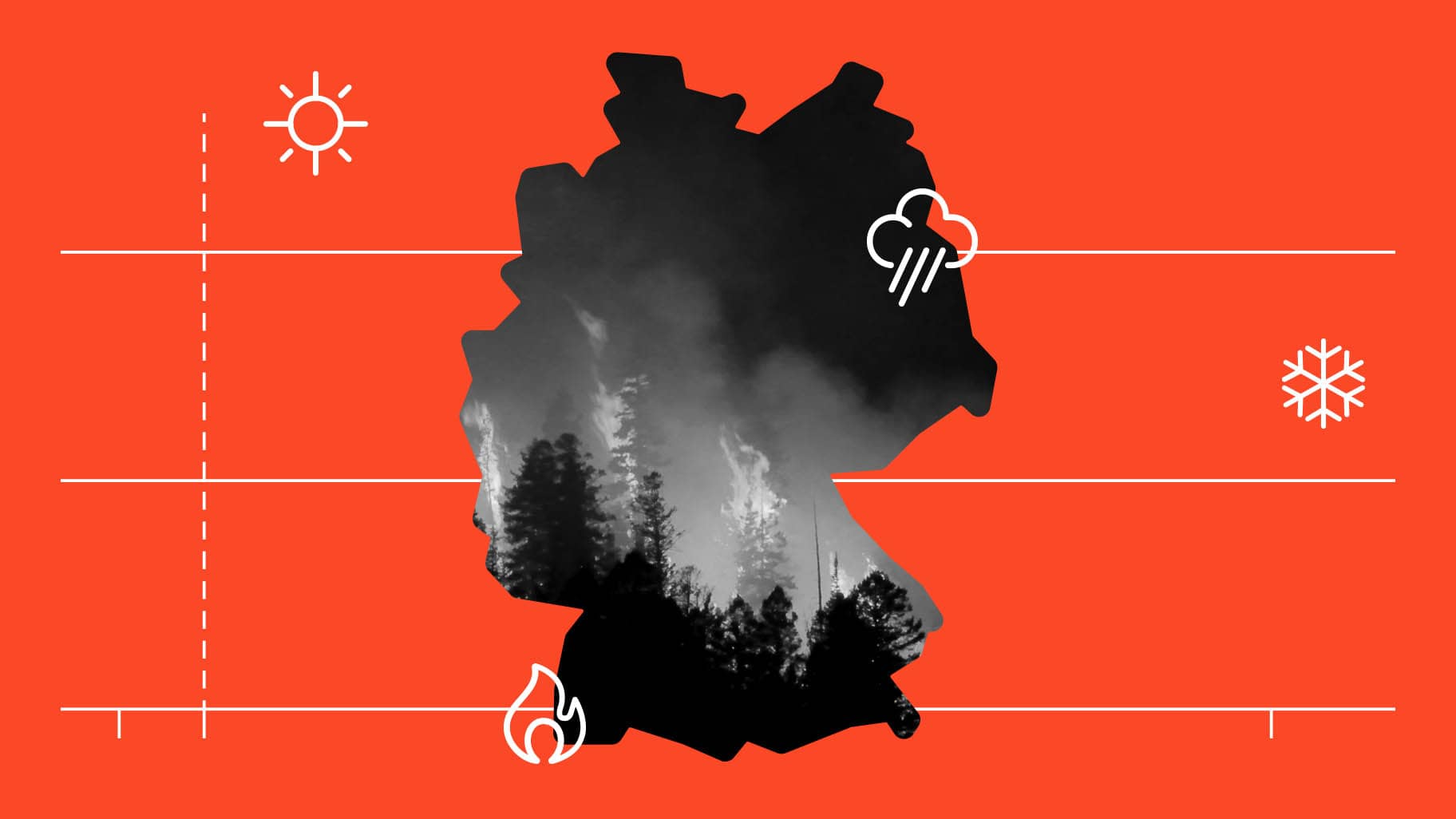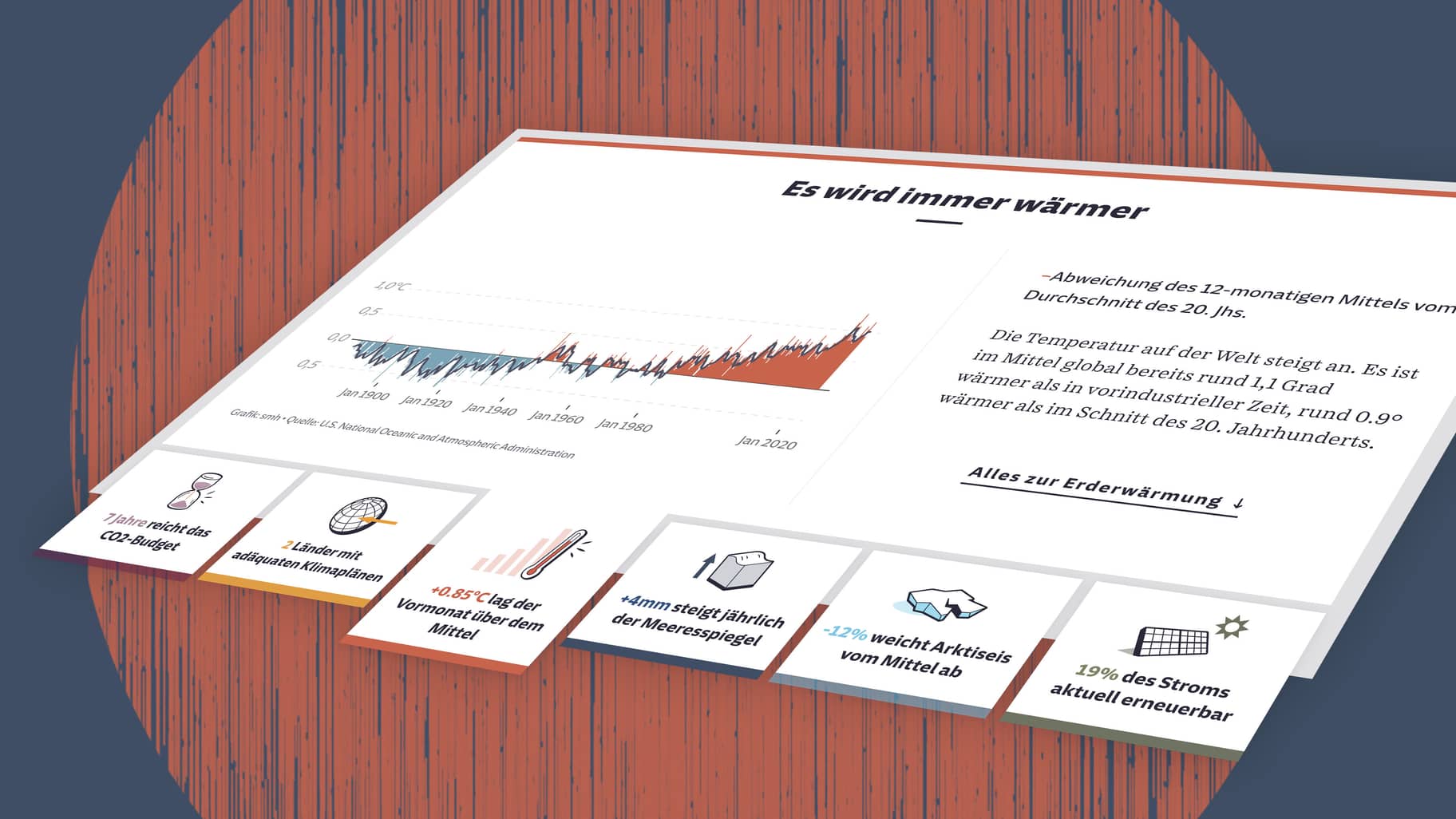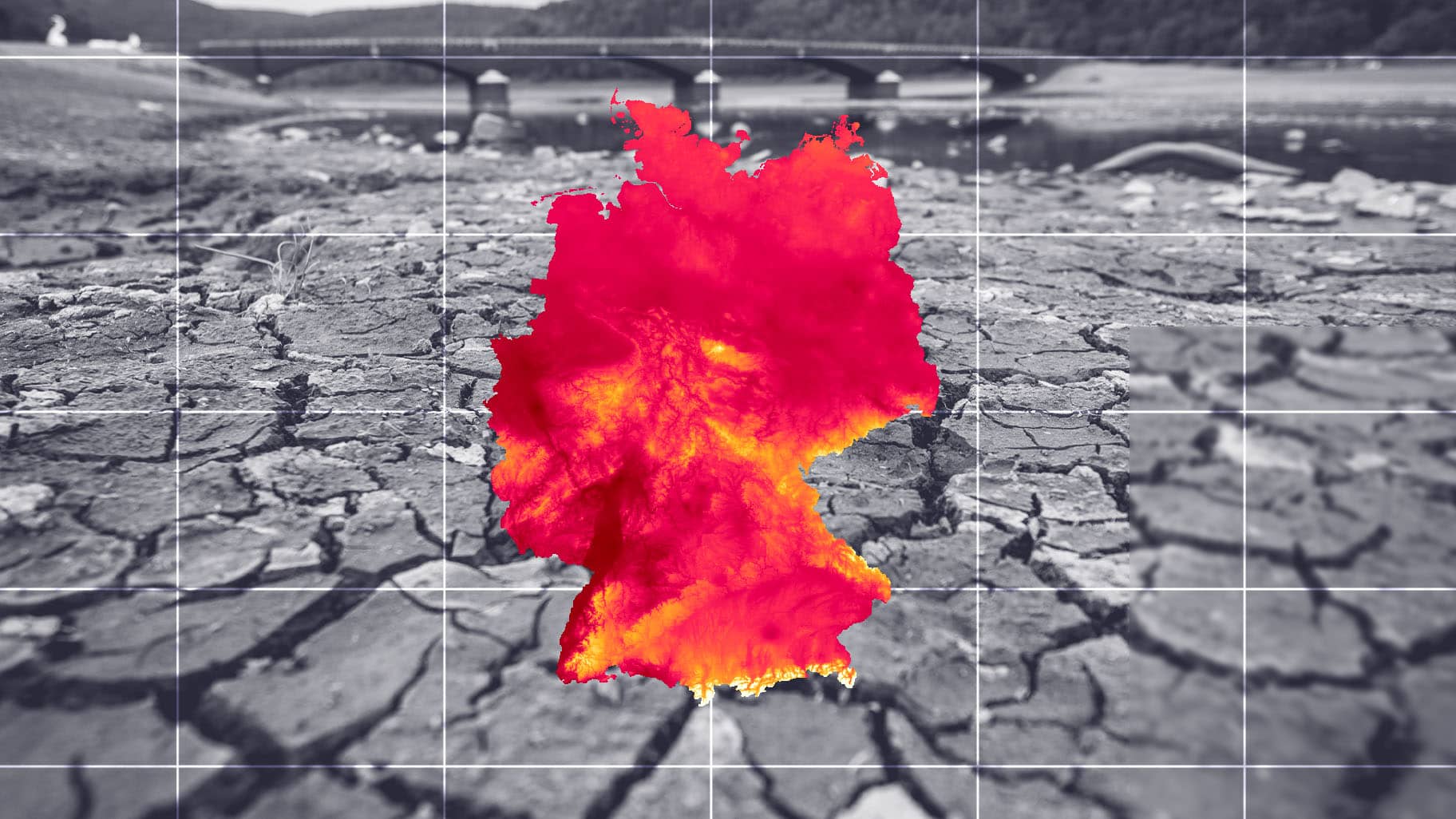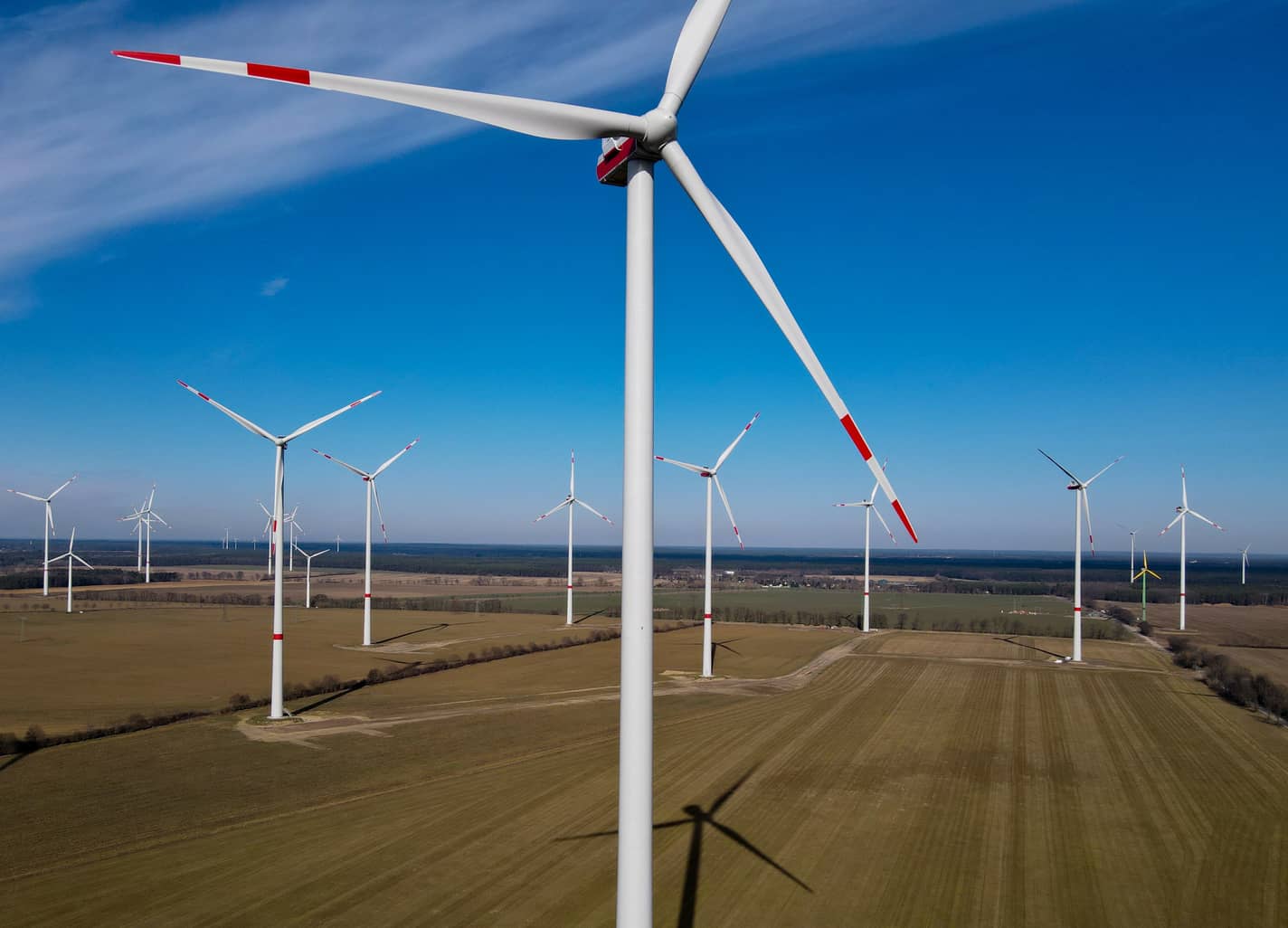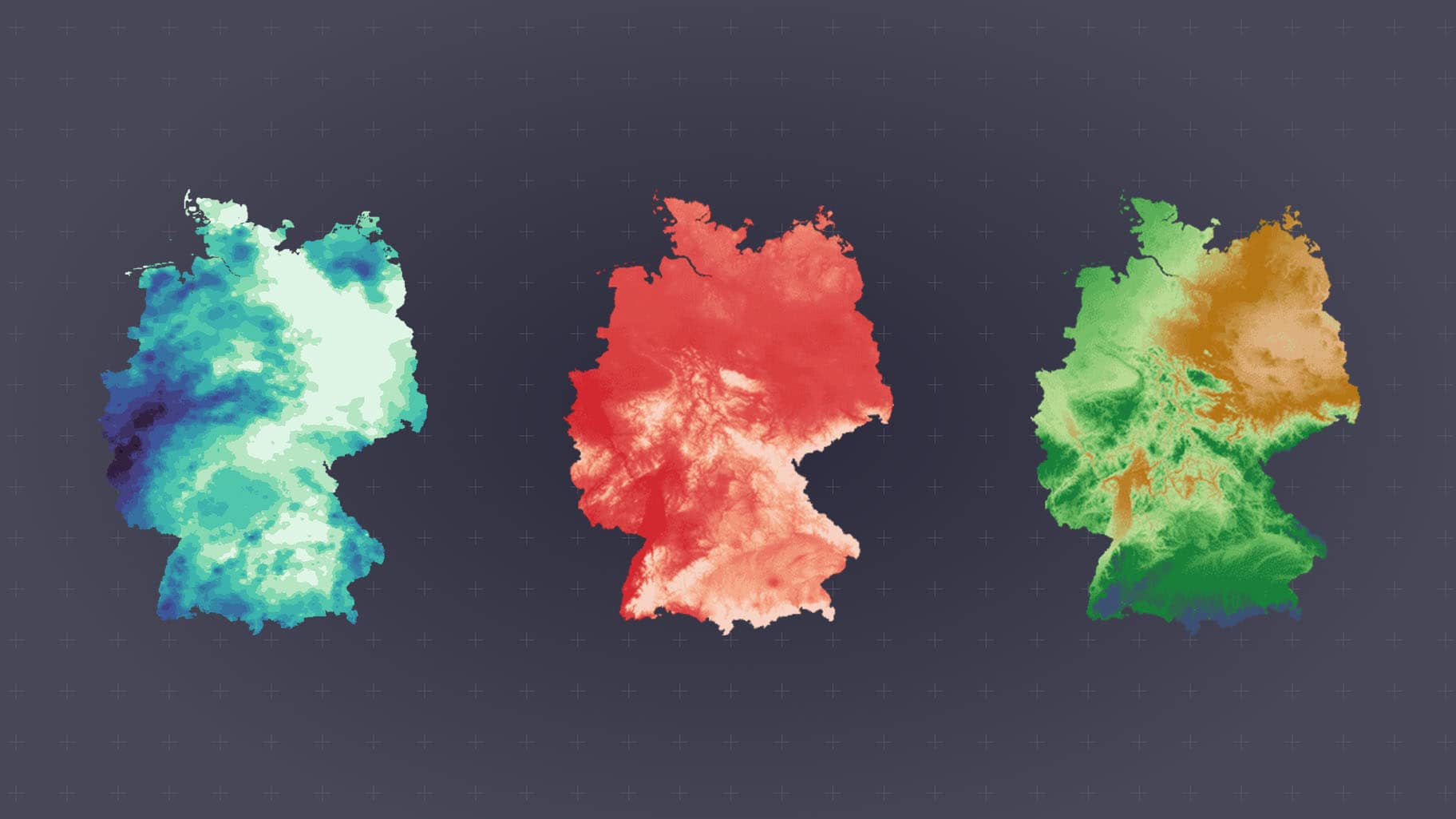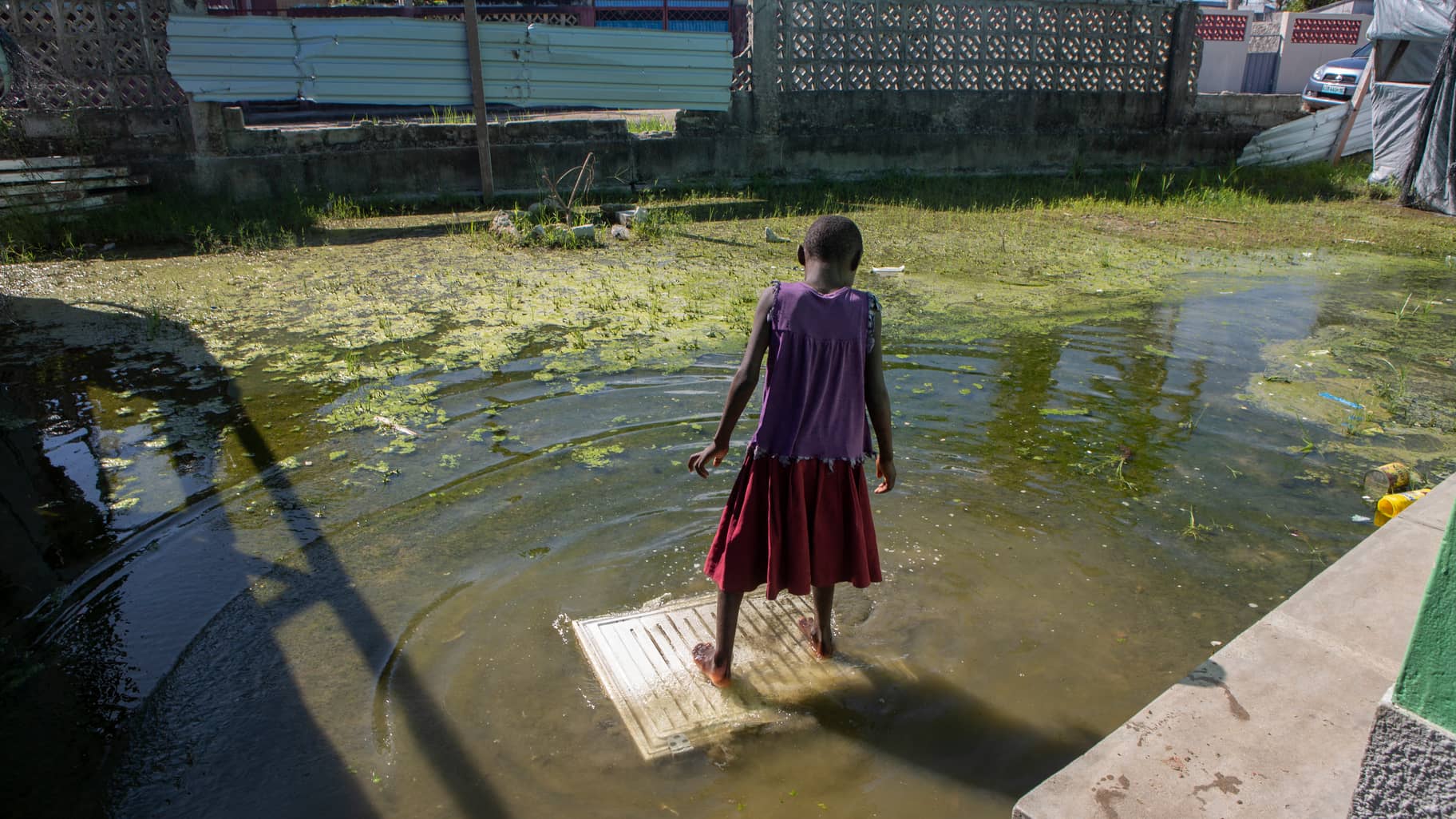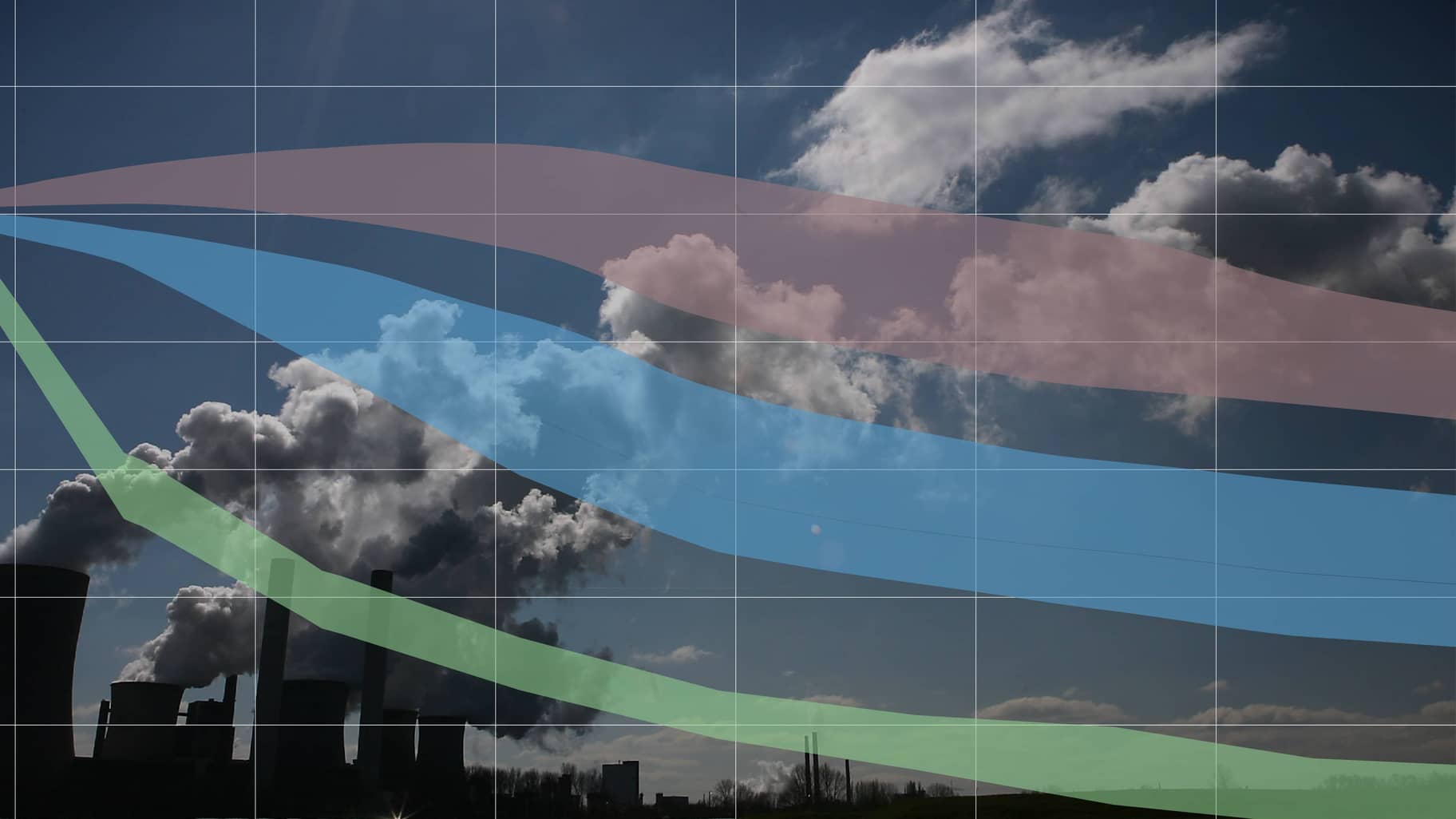2050 That sounds like science fiction, flying cabs, colonies on Mars. But we're actually only looking ahead 28 years, so the supposedly distant future is just as far away as it was in 1994. That was when Brazil won the World Cup in the U.S. and the age of the Internet began. When climate researchers look back, they notice one thing in particular: Back then, it was colder in Germany than it is today, summers were shorter, heat waves on the coasts were hardly known; in short, a lot of things were very different. Global emissions have increased even more since then, global warming will continue for at least a few more decades, and by the middle of the century, the consequences of the various climate scenarios will differ only in nuances, because the atmosphere is already overflowing with greenhouse gases. This has consequences, also for Germany.
A time travel through the climate future of 14 regions in Germany.
The region around Ludwigshafen is already one of the hottest areas in Germany. If the whole country is suffering from heat, it is usually even a few degrees warmer at the confluence of the Rhine and Neckar rivers. Between 1971 and 2000, there was an average of about five so-called hot days per year in Germany, days on which the thermometer showed more than 30 degrees Celsius. In the region around Ludwigshafen, there were more than twice as many, with 12.1 hot days, and almost 25 hot days are expected there by the middle of the century.
Hot days
in the region surrounding Ludwigshafen
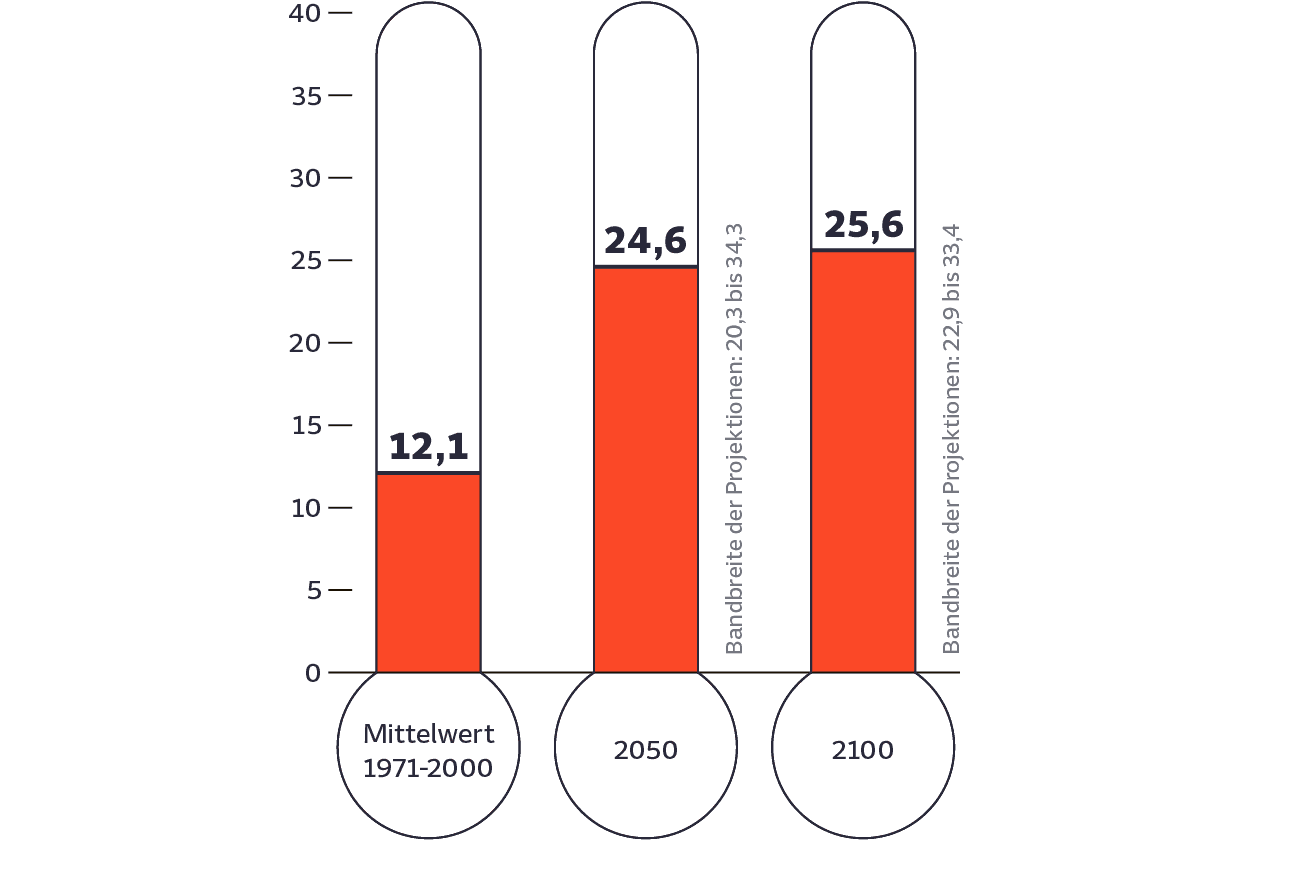
If you look at the whole country, it will be about 1.6 degrees warmer on average by 2050 compared to the end of the 20th century. So people and nature everywhere will suffer more from extreme heat.
If you want to know what our climate of the future will feel like, you should go to France. That's according to a study by the Umweltbundesamt (Federal Environment Agency, UBA), in which the authors compared climate forecasts for 41 German cities with values from the past, thus calculating "twin cities". The result: even today, the climate in many German cities is roughly the same as it was fifty years ago, a hundred to six hundred kilometers to the south.
Climatic twin cities
Climate of German Cities in 2050 Compared to Southern European Cities between 1961 and 1990
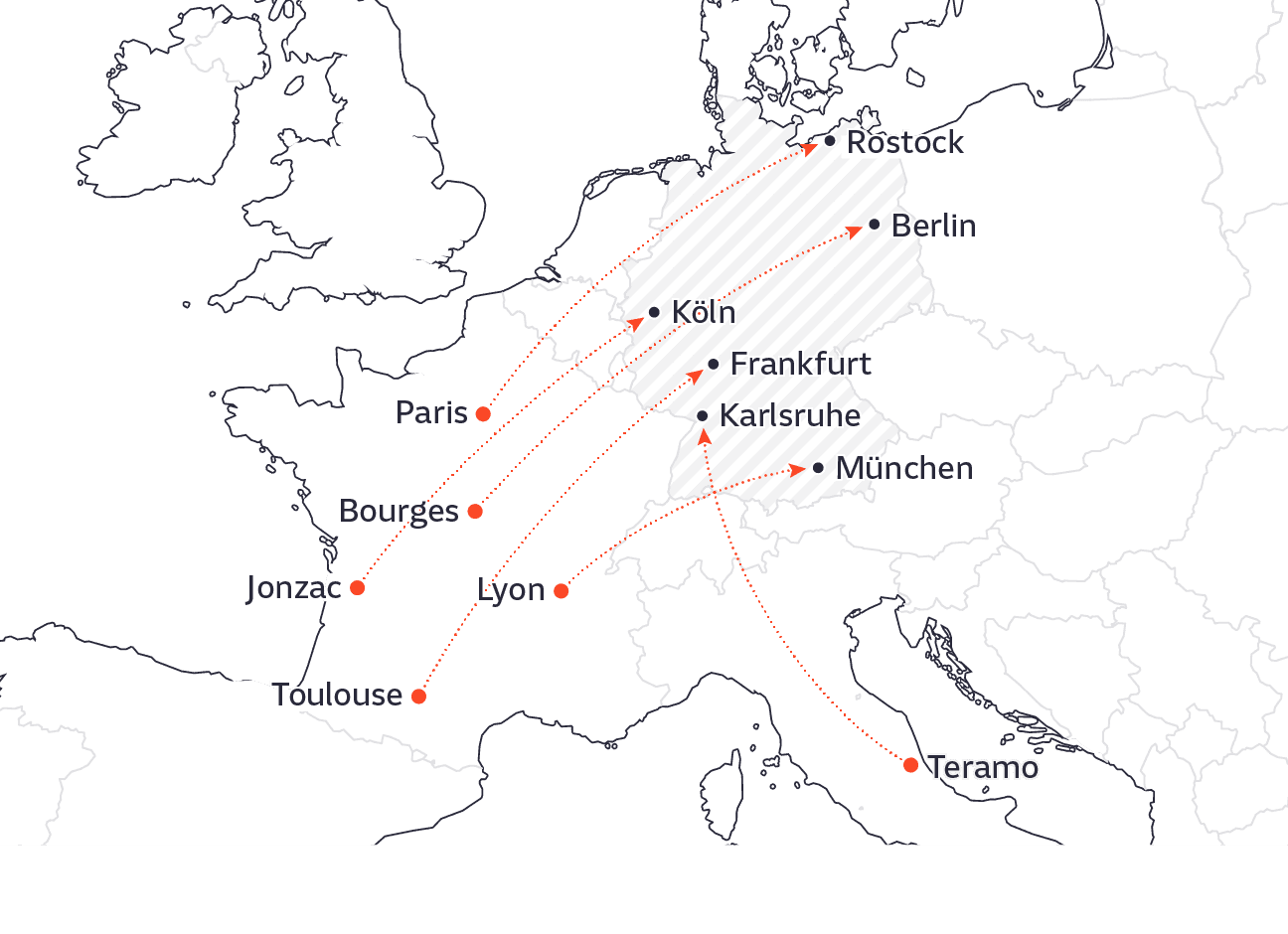
By the middle of the century, it could become as warm in many places as it used to be in central and southern France. Berlin would then be climatically located near the French city of Bourges, Munich in the area around Lyon, Cologne near Jonzac in the vicinity of Bordeaux, Frankfurt near Toulouse and Karlsruhe south of San Marino in central Italy. The only difference is that these cities, for their part, will long since have a different climate and the German cities, in turn, are not structurally made for such temperatures.
Most people in Germany already experience a white Christmas, meaning a blanket of snow between December 24 and 26, only once every ten years. The German Weather Service DWD has calculated this for the years 1990 to 2020. In the previous thirty years, the chance of a snowball fight was twice as great.
Munich, where snow fell every three years at Christmas from the 1960s to the 1980s, has been hit particularly hard: Now the city is covered in snow only every seventh christmas. In the coming years, a white Christmas will become less and less likely in most German cities, according to the "White Christmas Index". In Munich, the chances of this happening will shrink by about half again by 2050. Although this is more of a rudimentary estimate, its tendency is in line with other studies on winter: The cold season will be shorter overall, and precipitation is more likely to fall as rain instead of snow.
Ice days 2050
Days with a maximum temperature below zero degrees Celsius
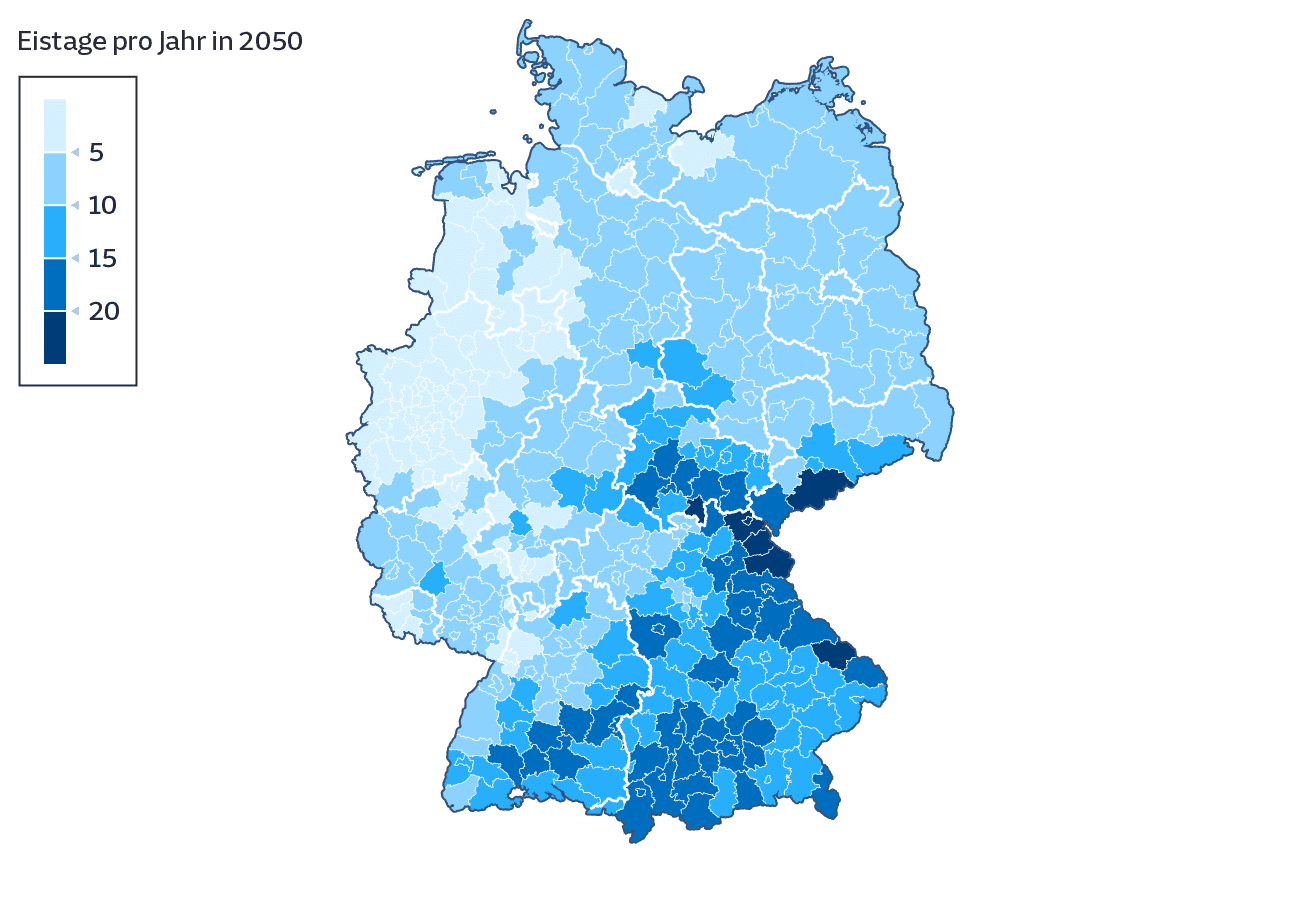
In many places, the number of ice days, when the temperature is below freezing, is also declining: In the Cologne region, for example, there could be no more ice days at all in 2050, and on the border with the Czech Republic the number could be halved from 40 to 20 days.
It does not happen in Germany that entire parts of the country are in flames as in Australia, but there are regularly smaller and somewhat larger forest fires, about a thousand a year. Fires are particularly frequent in the east: the pine forests on sandy soil, which cannot store moisture so well, burn more easily anyway. If there is then a lack of precipitation, the temperature rises and wind blows, the risk of forest fires increases.
Forest fire risk in July 2050
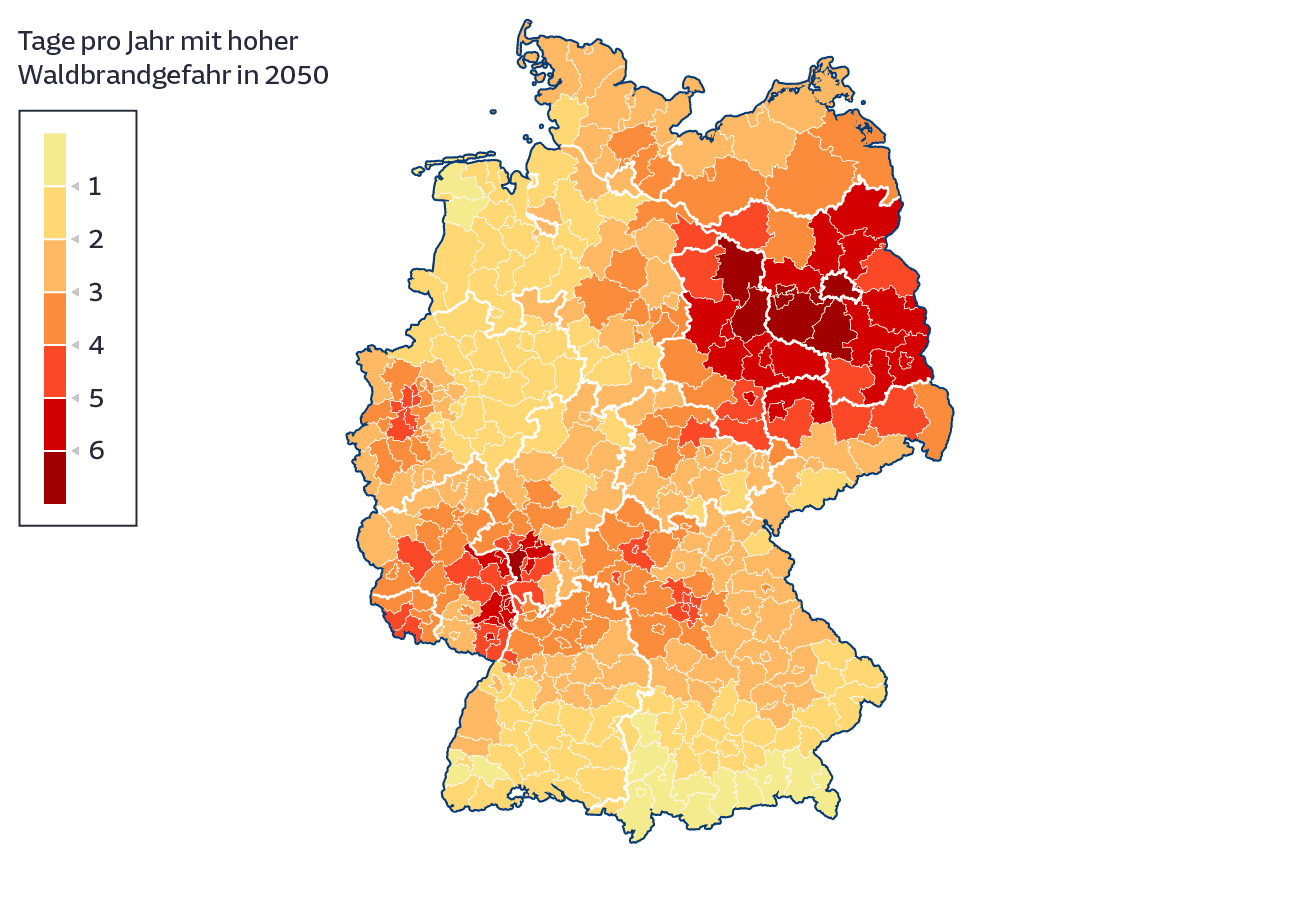
The risk will increase particularly strongly in the region around Schweinfurt in Lower Franconia and on the border between Hesse and Rhineland-Palatinate. In Schweinfurt, the number of days with a high risk of forest fires will more than triple in July, to four days, and double to more than five days in the Middle Rhine region. In Berlin and the southwestern regions of Brandenburg, there will probably be a high risk of forest fires on more than six days by mid-century. But: a higher risk does not automatically mean that there will also be more frequent fires. The fires have to be ignited. In past years, humans were mostly responsible for this.
More than 220 people died in Western Europe in 2021 after a flood, 186 of them in Germany. Within a very short time, huge masses of water caused economic damage of 46 billion euros. A rain of the century. As difficult as it is to attribute individual events to climate change, studies clearly show that such flood disasters have already become much more likely as a result of climate change. Even if such floods of the century remain rare, heavy rainfall will tend to increase further in Germany by the middle of the century.
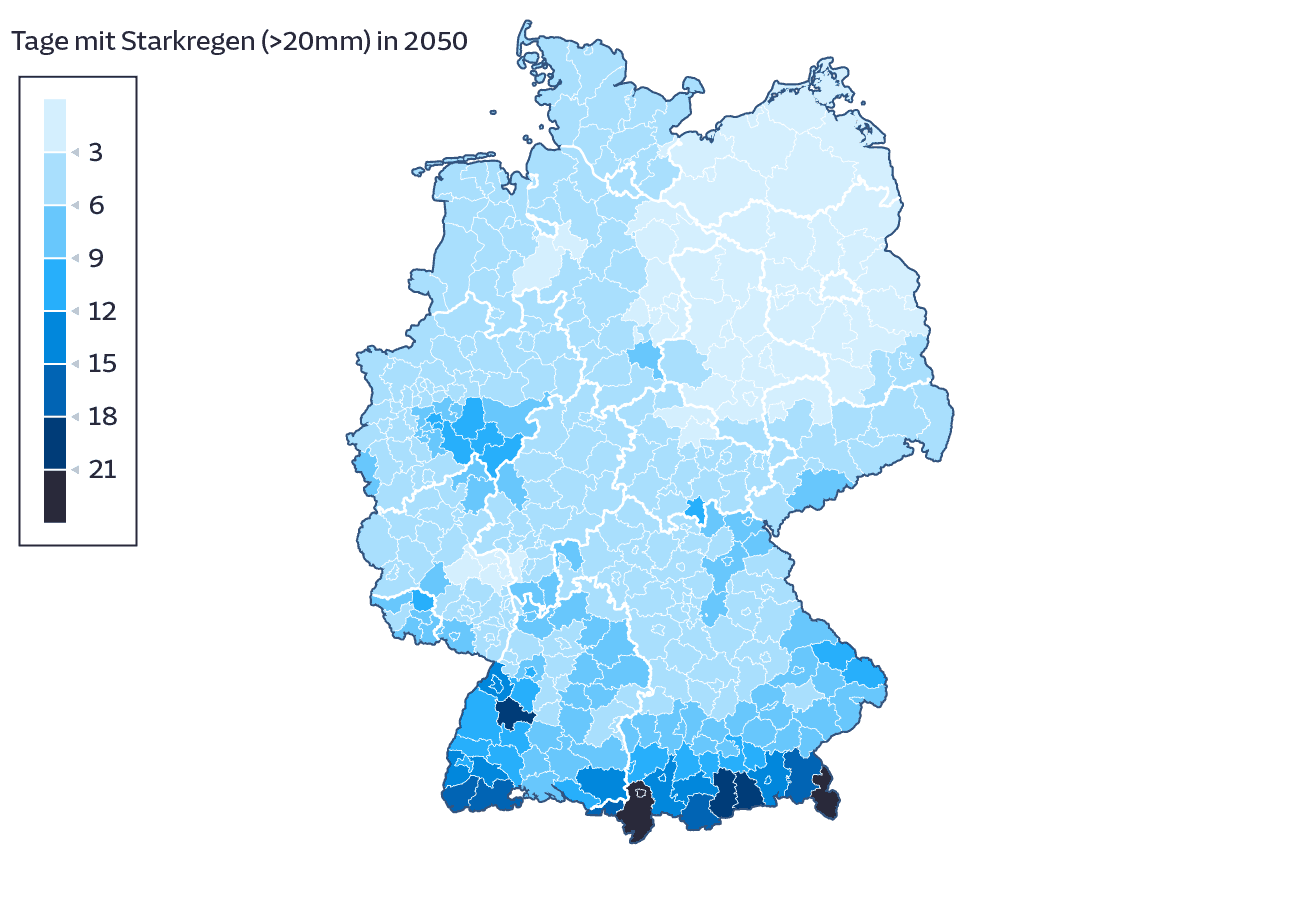
In 2050, heavy rainfall is more likely to occur on the edge of the Alps, for example in the Allgäu region, than on the Ahr and Erft rivers. It already rains much more there than in the rest of the country. But: How much damage the water causes also depends on the nature of the terrain, the built-up area and flood protection.
In the region around Saarbrücken, summers are already dry today. In the future, by the middle of the century, it will remain dry there on about 65 days in June, July and August, meaning less than one liter of rain per square meter. That is three days more than in the comparative period from 1971 to 2000.
Extreme weather 2050
in the Saarbrücken region
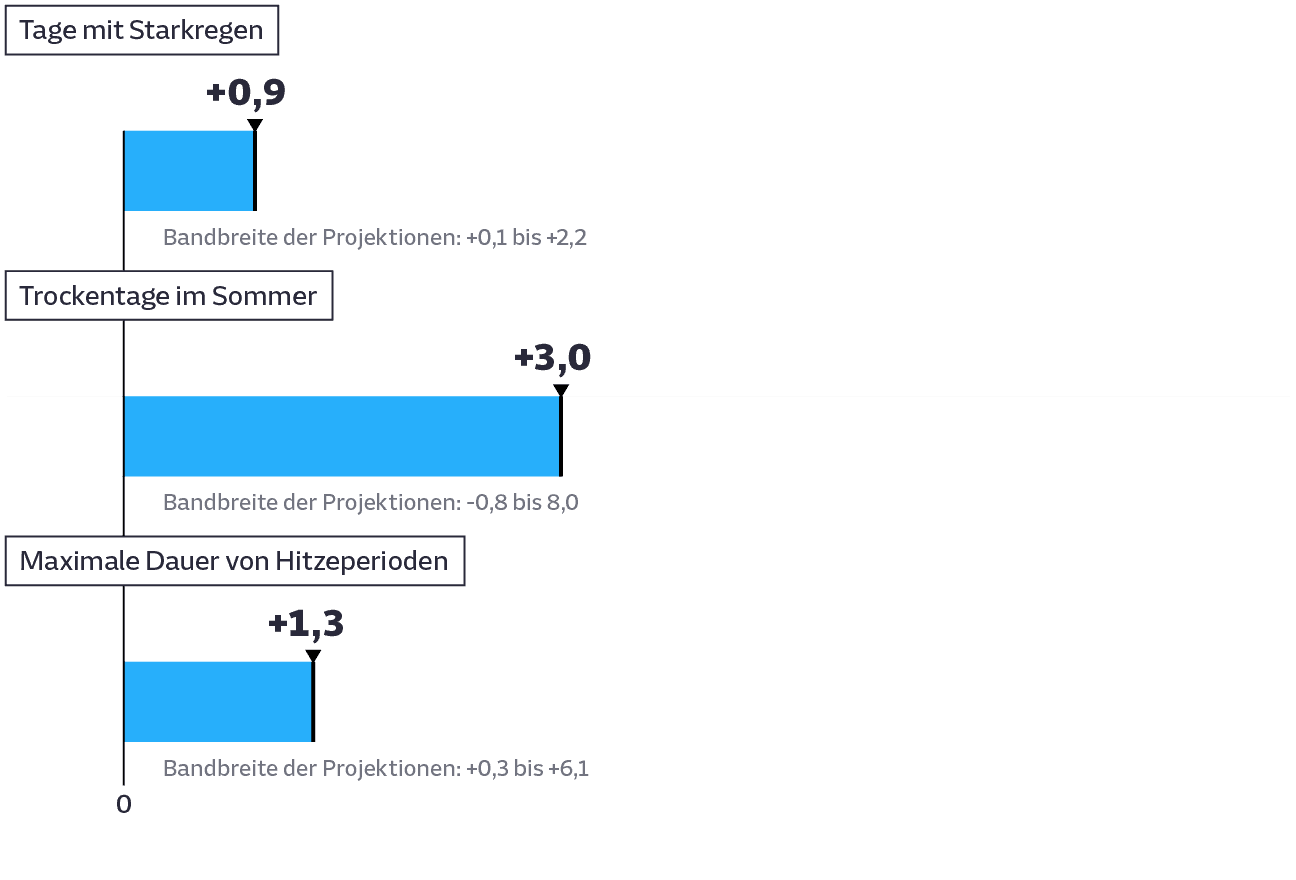
It will rain less frequently, but more heavily. Therefore, in 30 years, the total amount of rainfall in summer will still be about the same as in the past. But the precipitation will be more concentrated on fewer days. So everything is not so bad? Unfortunately not, because Germany is warming up, more water will evaporate. To compensate for this loss, it would have to rain more than in the past. That is unlikely to happen. That is why soils in large parts of Germany are drying out, first on the surface and then in the deeper layers.
With the exception of the coastal regions, it will remain dry more frequently throughout the country in the summer months. This is a major problem for forests, but also for agriculture; plants need the water stored in the soil to survive periods without precipitation. And heavy rainfall does little to help the plants: the soils cannot absorb so much water at once; instead, it runs off quickly, taking valuable nutrients with it, and in the worst case, the large amount of water destroys the crops in the fields.
Already today, up to 300,000 people older than 65 die each year worldwide due to heat; in Germany, there were 8700 heat-related deaths in 2018, according to a calculation in the medical journal Deutsches Ärzteblatt. At the time, Central Europe was experiencing exceptional heat waves - but this could be more frequent in the future, and what this means in terms of health has been calculated by researchers for the greater Augsburg area.
Here, an average of 967 heart attacks were registered so far in a year. If global warming can be limited to around two degrees Celsius, the scientists assume that 18 additional heart attacks will occur in a decade, and 63 more at three degrees Celsius. At less than 1.5 degrees, on the other hand, the number of heart attacks would fall slightly, because the number of cold-related heart attacks is likely to decline as temperatures rise.
Change in heart attacks due to rising temperatures
in the Augsburg Metropolitan area
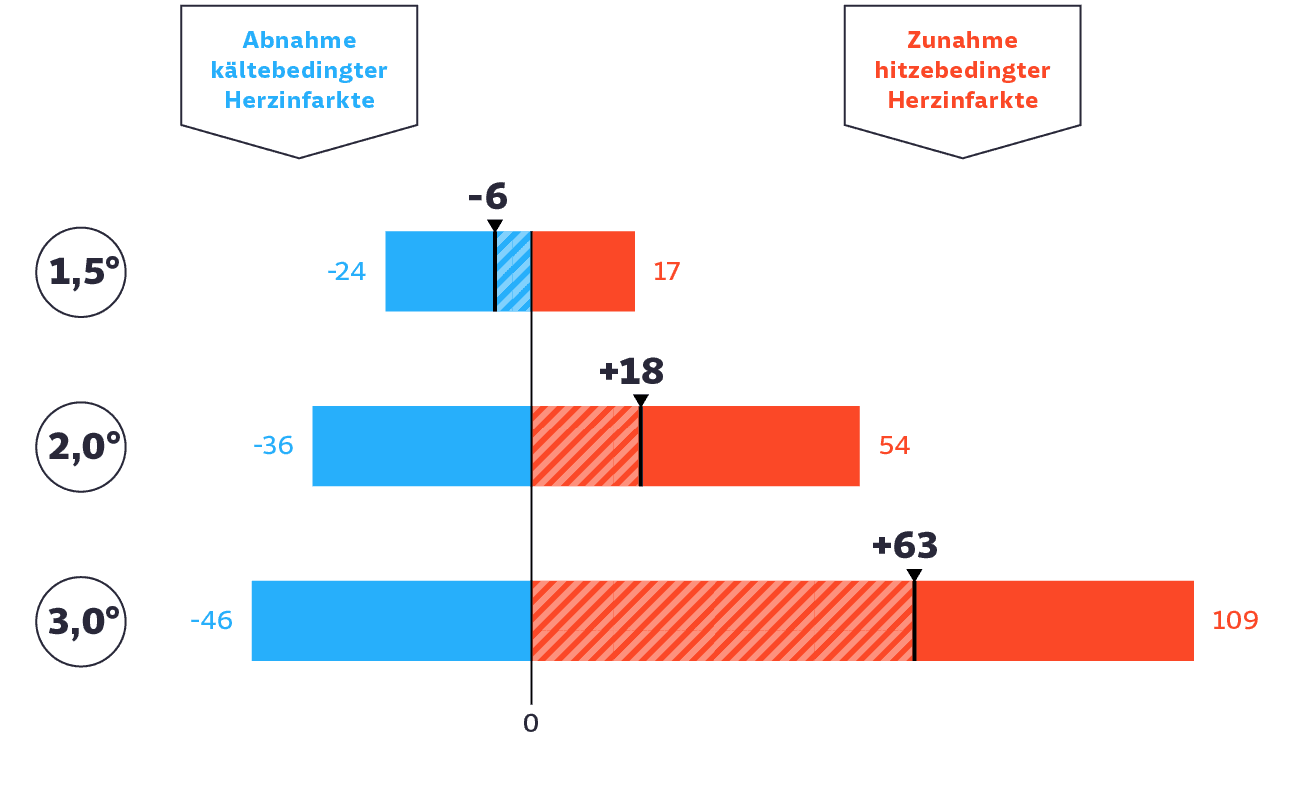
Therefore, the overall difference in infarcts may not be so great, but heat also leads to cramps, dehydration or heat stroke. The body can then no longer cool itself down by sweating. The internal temperature exceeds 41 degrees, the heart races, one becomes disoriented or even unconscious, and if not treated, death threatens.
Many ski resorts are already struggling with a lack of snow. The German alpine association DAV has investigated how snow reliability could develop in 46 Bavarian ski resorts between Oberstaufen and Berchtesgaden. According to the study, from 1971 to 2000, a hundred operating days per winter were possible in about a third of the ski areas, and in most of the others at least thanks to artificial snow. But even with a temperature increase of two degrees, only seven ski resorts would still be completely snow reliable, and without artificial snow only the Zugspitze and Nebelhorn ski resorts.
Snow reliability
of 46 Bavarian ski resorts in the Alps
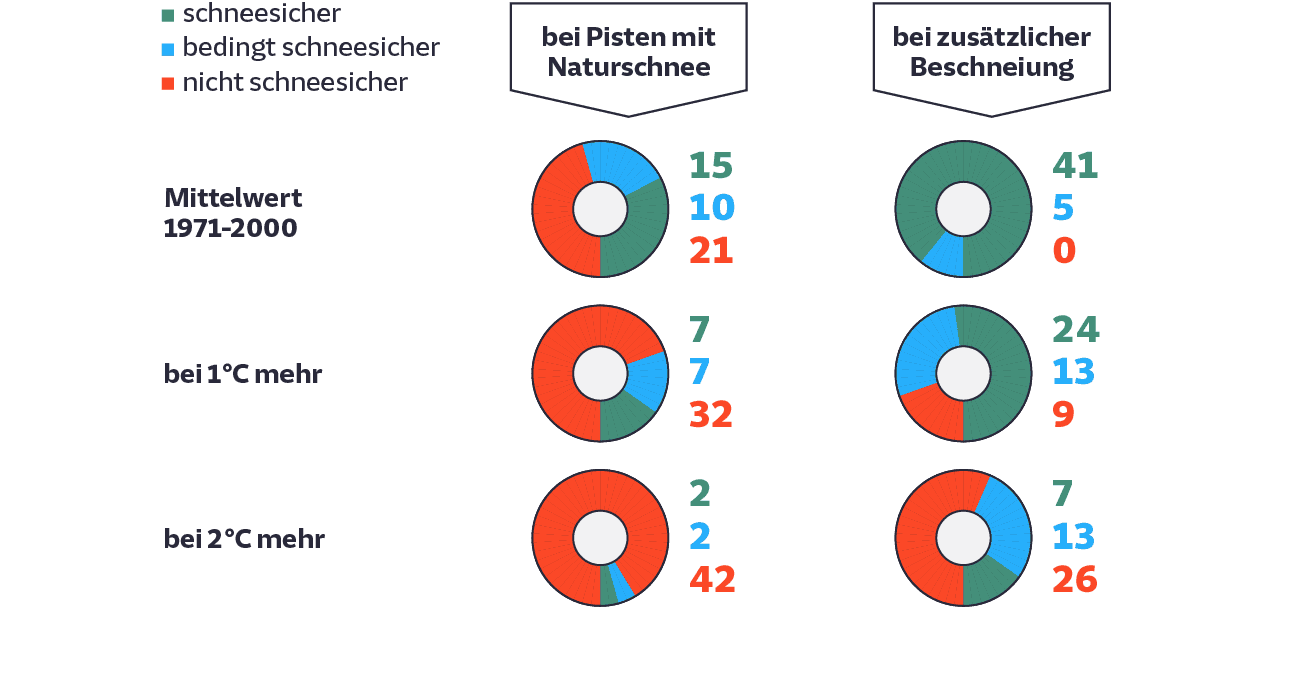
This does not mean that all other ski areas have to close. Many lifts are profitable even with fewer than 100 operating days a year. But clearly not all of them.
Around 360 kilometers of roads and 80 kilometers of railways lie in the flood zone of the Rhine and its tributaries alone. According to a study by a network of experts at the German Ministry of Transport, about half of the road sections at risk will be affected by flooding at least twice as often - and already in the near future until the middle of the century.
Federal highways with risk of flooding
Road sections that would be flooded in the event of an extreme flood
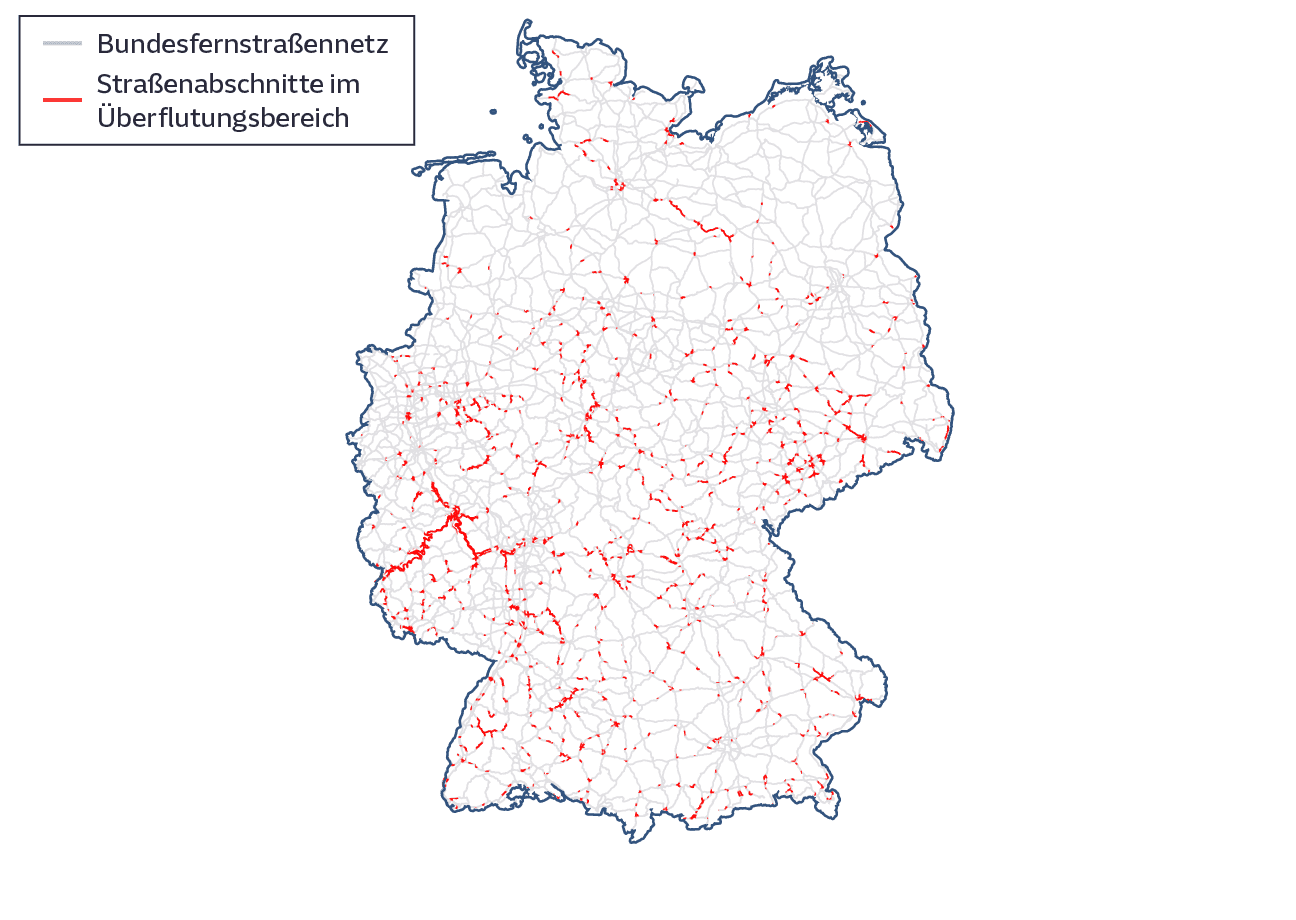
According to the study, the hamlet of Maxau in Karlsruhe, which is located directly on the Rhine, will be affected by a moderately severe Rhine flood every 20 to 35 years in the near future instead of every 100 years. The small town of Plochingen will have to expect a moderately severe flood every 23 to 35 years instead of every 100 years due to climate change. Thus, by 2050, the intervals between flood disasters will become shorter and shorter.
Climate change will be stressful in terms of health. Also because the burden on people with allergies will increase. Higher temperatures and a higher carbon dioxide content in the air ensure increased plant growth and thus also increased pollen production. Many plants begin to bloom even earlier as temperatures rise, allowing them to spread pollen over a longer period of time. In a worst-case scenario, one pollen season could merge into the next with almost no respite. For the German Weather Service, the alder, which gets going particularly early every year, is the crucial indicator plant:
Beginning of alder flowering 2050
On what day of the year the alder begins to bloom
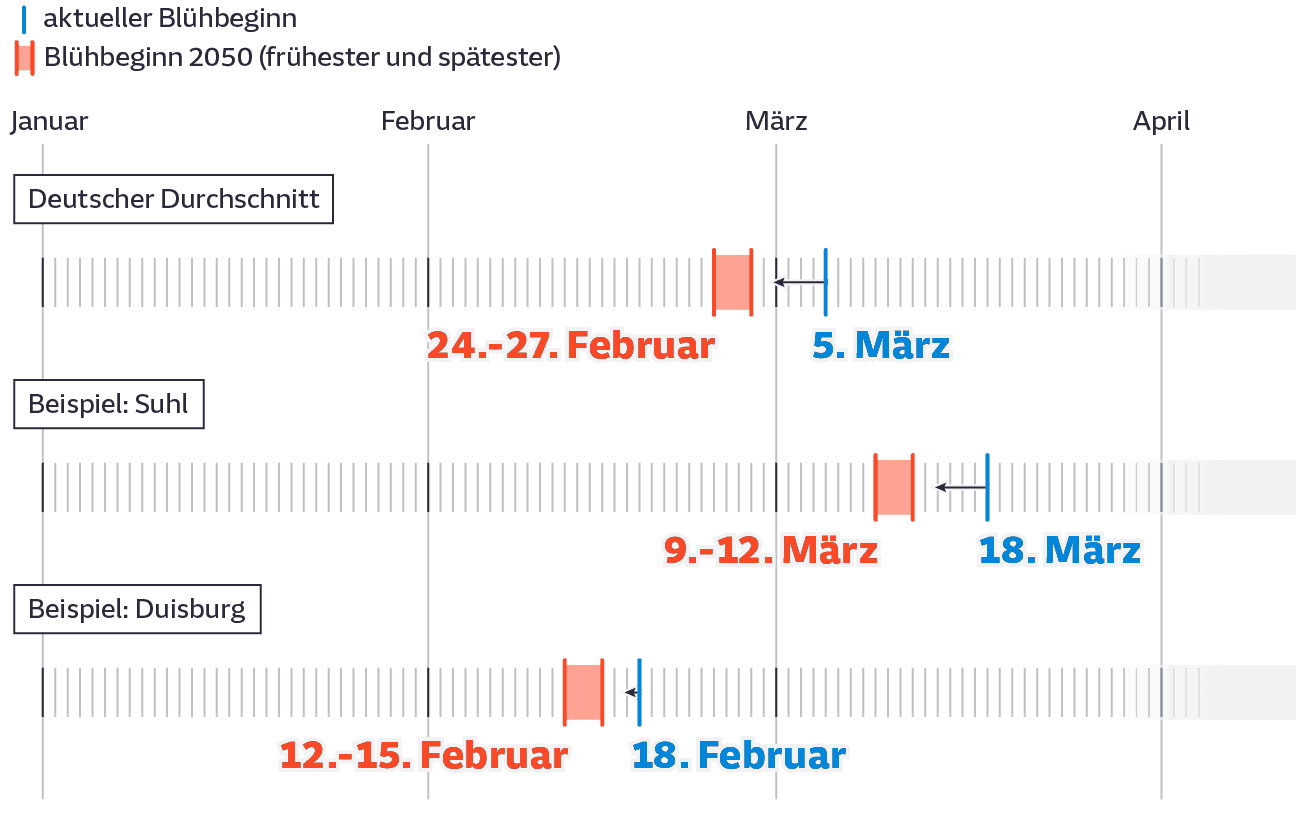
According to the calculations, the alder will bloom on average five to eight days earlier in Germany in the middle of the century than it does today; in the northeast and especially in the low mountain ranges, even seven to ten days earlier.
Coastal regions will have to contend with problems of their own as a result of climate change. The Baltic Sea will be particularly affected by the consequences of rising water temperatures. In its Climate Impact and Risk Analysis 2021, the Federal Environment Agency UBA assumes that the surface water in the Baltic Sea could be three degrees warmer on average at the end of the century than in the last third of the 20th century.
Baltic Sea water temperature
at Fehmarn Belt
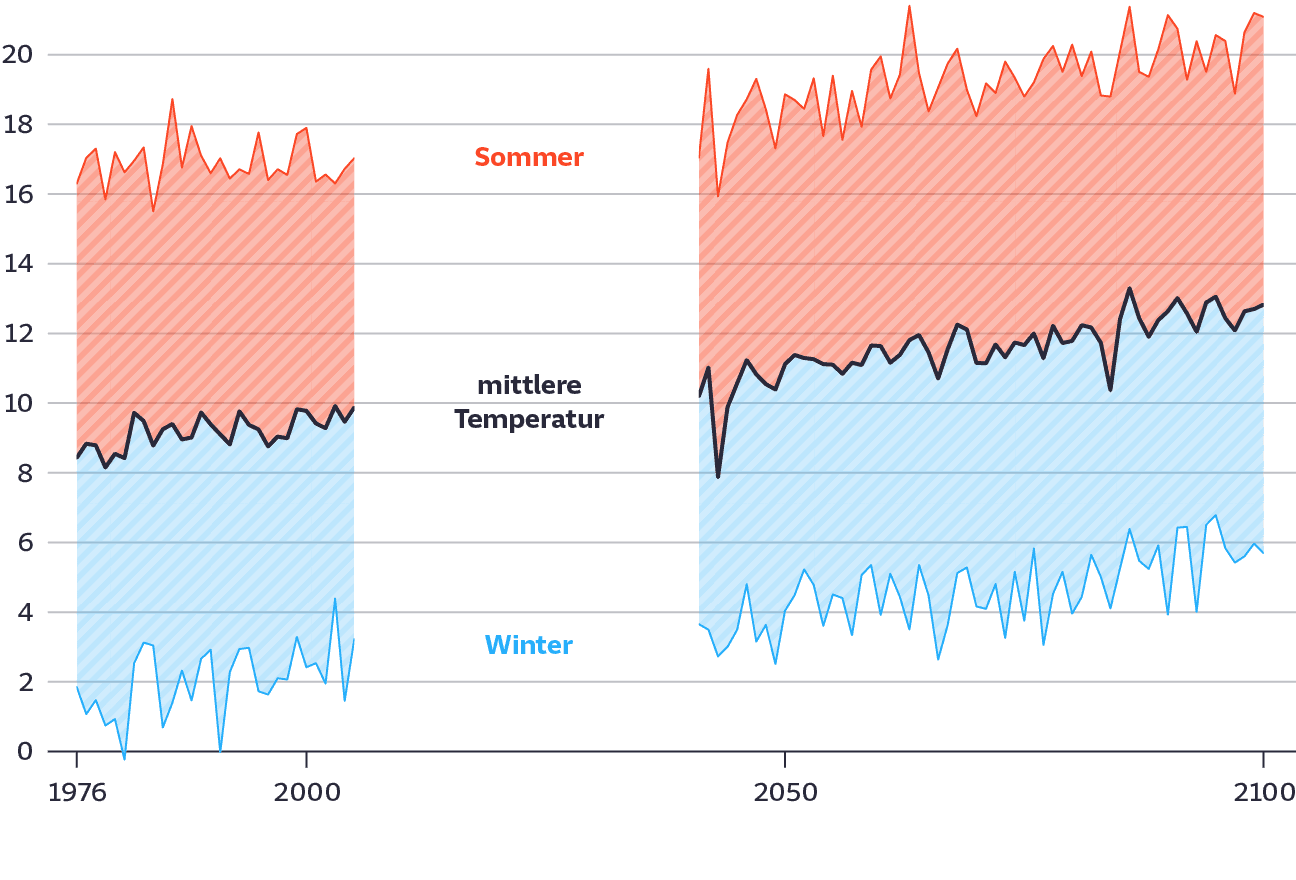
Temperatures change not only the living conditions for aquatic plants and animals, but also those for bacteria. They often find it easier to multiply in warmer water - for example, vibrios, which can also be dangerous to humans. They could then spread earlier in the year and over a longer period of time. Anyone who swallows contaminated seawater or bathes with open wounds can become infected with these germs. This can result in diarrhea, blood poisoning or severe wound infections, especially in people who are already ill or weakened.
From the beginning of 2018 to the spring of 2021, according to the analysis of satellite data, tree stands were destroyed on an area of more than 500,000 hectares - that's almost five percent of the total forest area. And the burden will increase. For one thing, it will get hotter and drier. By mid-century, studies suggest that oak or pine, for example, could be only slightly or moderately threatened by drought stress in Germany, while the deterioration of beech and spruce will be "downright dramatic".
Tree species endangered by drought
in a scenario without climate protection throughout Germany
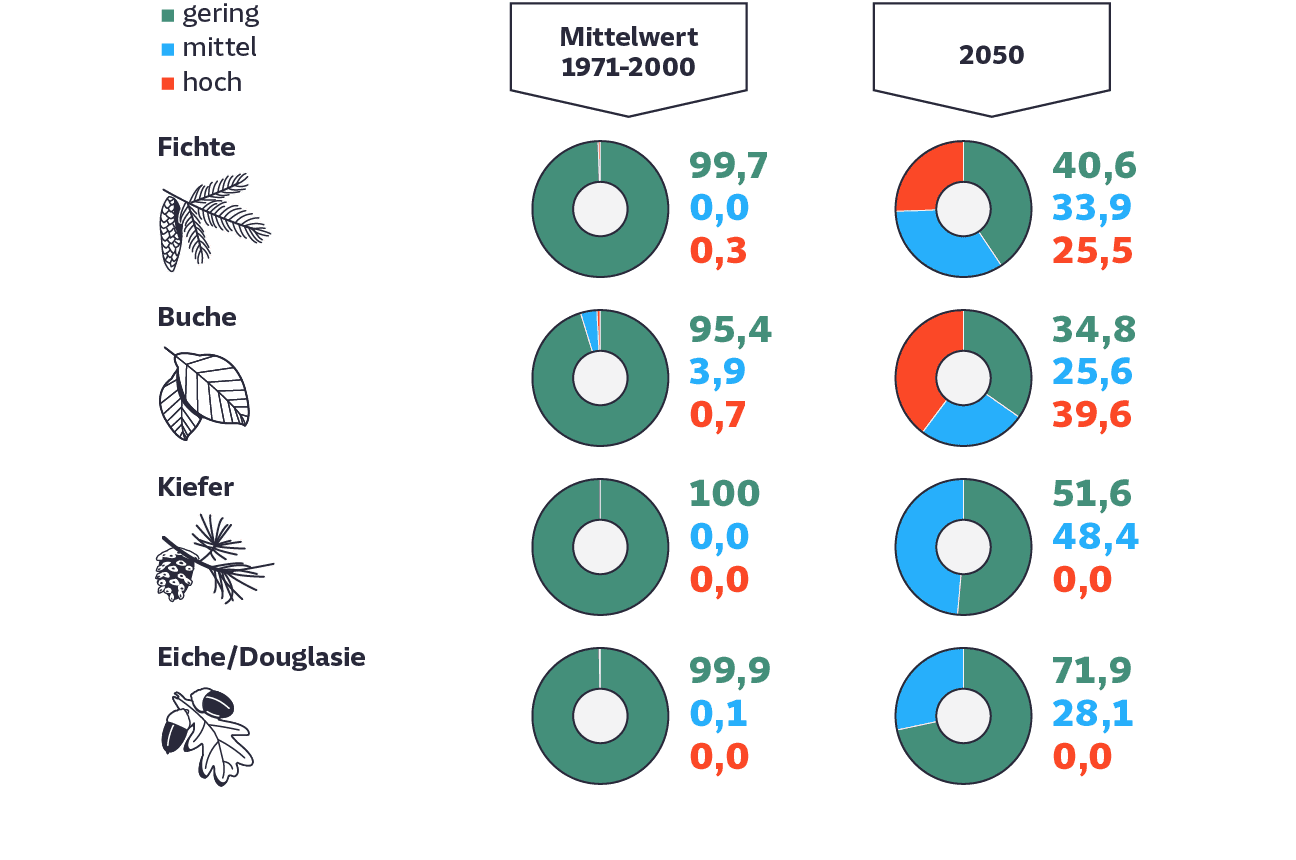
In concrete terms, this means that the trees grow less well, are more susceptible and - if other risks such as storms or pests are added - may also die. The Rhine region, the north, the northeast and low mountain ranges such as the Odenwald are particularly affected.
Around half of the 38 bumblebee species still found in Germany today are considered endangered. In the Wesermarsch in the district of Cuxhaven, for example, the great yellow bumblebee or "dyke bumblebee" can hardly be found anymore. Its habitat will shrink even further due to the climate crisis.
Habitat suitable for the dyke bumblebee 2050
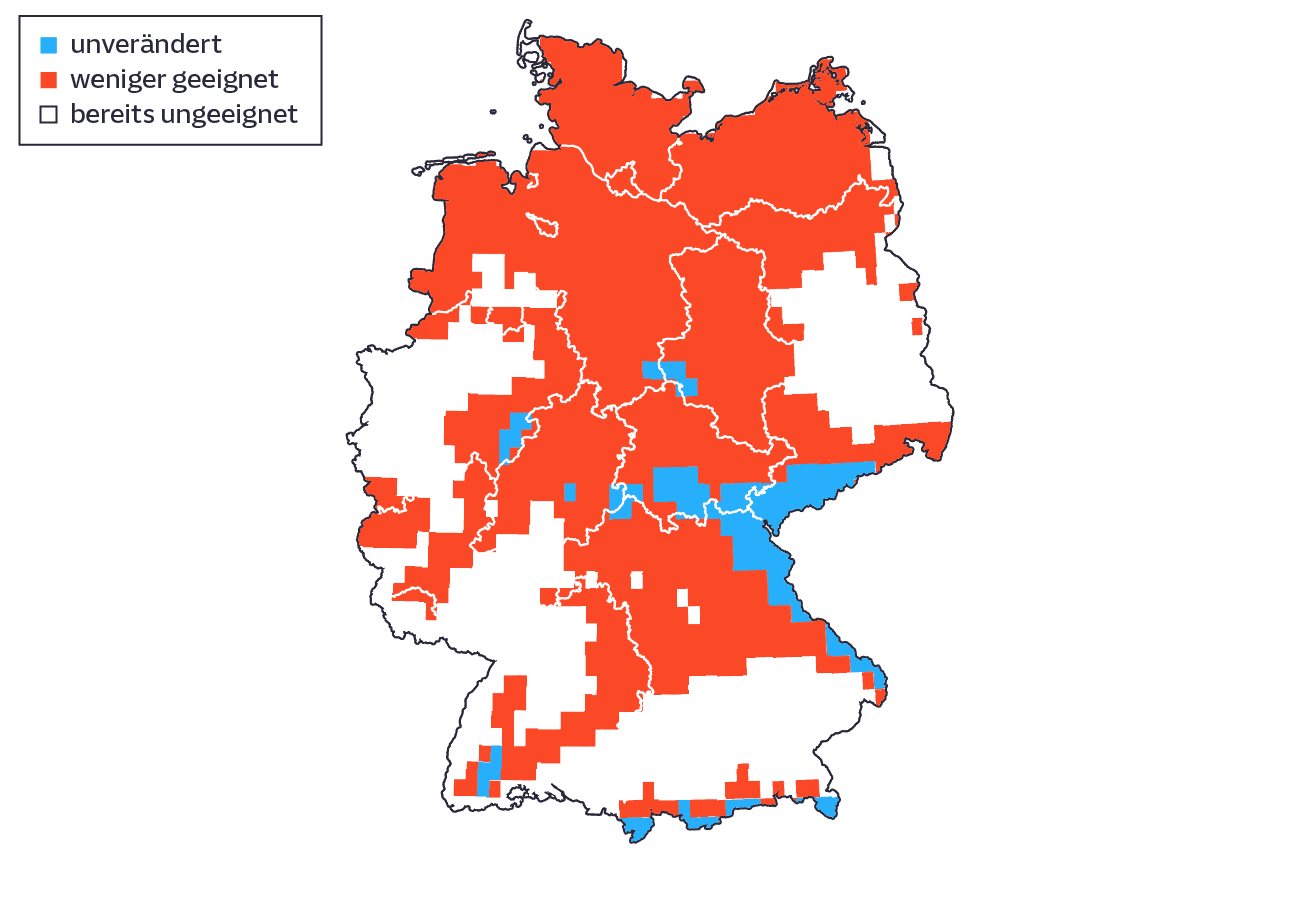
According to a climate atlas of Europe's bumblebees, only a few undemanding generalists such as the large earth bumblebee or the common carder bee will survive until the middle of the century. This means that the most important pollinators for crops such as tomatoes, potatoes and blueberries will be lost. According to biologists, the few bumblebee species from the south are unlikely to be able to fill the gaps.
Back in 2011, the German Federal Agency for Nature Conservation studied the climate risk for 500 species in need of special protection. Most high-risk species were found in the butterfly group, followed by mollusks and beetles. The inhabitants of peatlands are particularly at risk from climate change because their habitats are increasingly drying out. These include butterfly species such as the cranberry blue or dragonfly species such as the subarctic darner, but also numerous amphibian species.
Mosquitoes are the most dangerous animals in the world: every year, around one million people die from infections transmitted by them. The tiger mosquito, which can carry Zika, dengue or yellow fever viruses, among others, contributes to this. It actually originates from tropical and subtropical regions of Southeast Asia, but was introduced into numerous European countries via long-distance travel and trade in goods.
In Germany, it has repeatedly appeared in Bavaria and Baden-Württemberg for more than ten years, and in some cases populations also manage to overwinter - for this to happen, temperatures must not drop below three degrees.
Tiger mosquito season length
On how many days of the year there are suitable climatic conditions for the tiger mosquito.
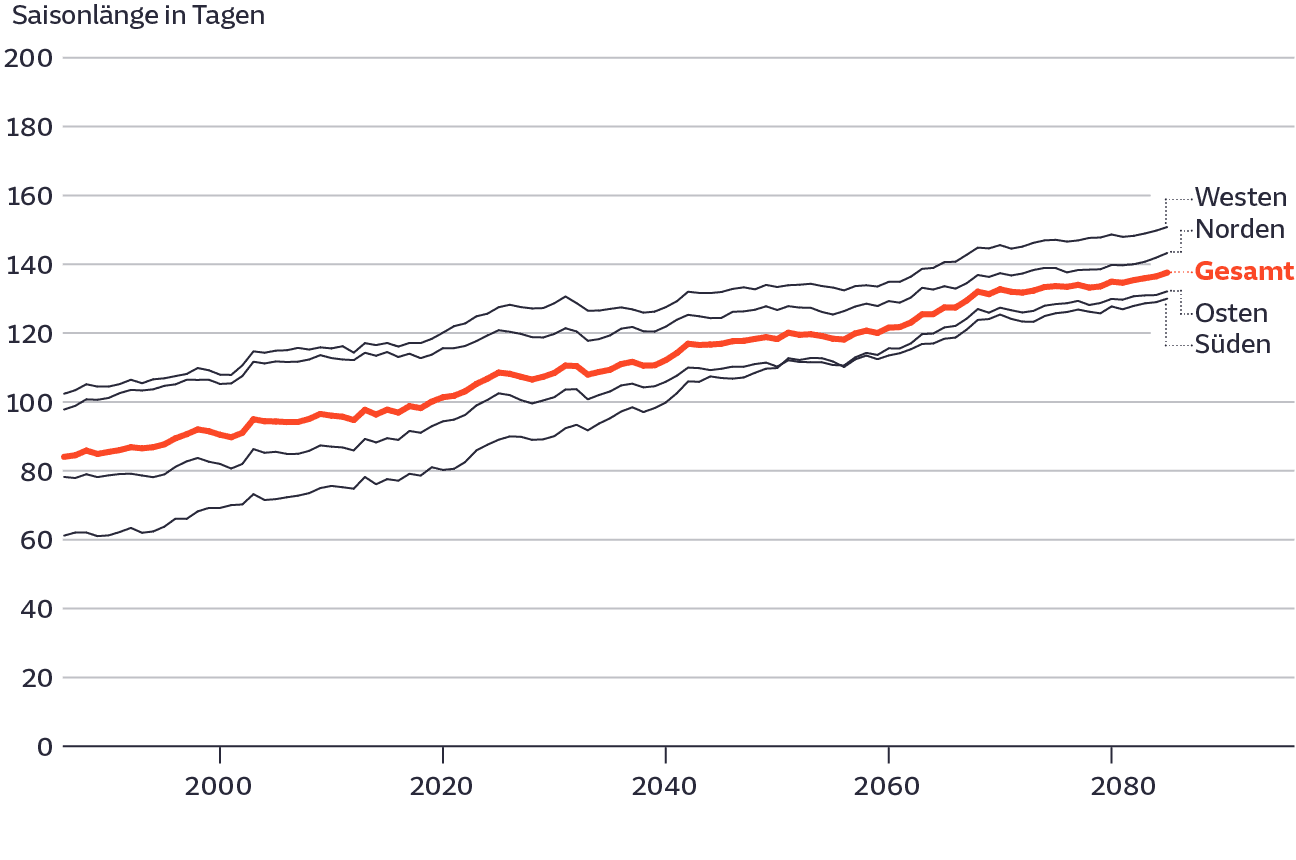
By mid-century, the tiger mosquito will also find good conditions in France and Central Europe - in Germany, particularly in the Lower Rhine, parts of the Ruhr, the Palatinate, and along the Rhine down to Lake Constance.
